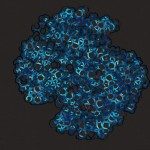Link to Pubmed [PMID] – 10559195
J. Biol. Chem. 1999 Nov;274(47):33220-6
MalT, the transcriptional activator of the Escherichia coli maltose regulon, binds the MalT-dependent promoters and activates transcription initiation only in the presence of maltotriose and ATP (or adenylyl imidodiphosphate (AMP-PNP)). Cooperative binding of MalT to the array of cognate sites present in the MalT-dependent promoters suggests that promoter binding involves MalT oligomerization. Gel filtration and sedimentation experiments were used to analyze the quaternary structure of MalT in solution in the absence or presence of maltotriose and/or AMP-PNP, ATP, or ADP. The protein is monomeric in the absence of ligands and in the presence of ADP. In the presence of maltotriose, AMP-PNP, or ATP only, the protein self-associates, but a large fraction of the protein remains monomeric. In the presence of both maltotriose and AMP-PNP (ATP or ADP), the protein is essentially oligomeric, with the difference being that the oligomerization is less favored in the presence of ADP + maltotriose than in the presence of AMP-PNP + maltotriose. We present evidence that the association pathway comprises the following steps: monomers –> dimers –> (MalT)(n) –> aggregates, where 3 </= n </= 6. From these data, we conclude that the role of maltotriose and ATP as positive effectors is to induce the multimerization of MalT, and hence its cooperative binding to the mal promoters.

